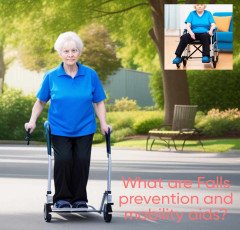
Falls Prevention And Mobility Aids

The tactics and actions used to prevent falls, particularly among older persons who are more vulnerable as a result of aging-related changes in their physical and cognitive capacities, are referred to as fall prevention.
Falls can result in severe problems and injuries, including fractures, brain traumas, a reduction in general health and mobility, and more. Exercise to develop strength and balance, environmental changes including minimizing trip hazards, and medication management to lessen side effects that could raise the chance of falling are some fall prevention measures.
Mobility aids are tools or pieces of equipment that help people who have mobility issues, like trouble standing or walking, go about their daily lives.
Mobility aids include things like canes, wheelchairs, scooters, and walkers. These tools can increase a person's mobility and independence while lowering the risk of falls and other accidents. It's crucial to remember that in order to ensure safety and effectiveness, mobility aids should be selected and utilized carefully, in conjunction with a healthcare practitioner.
Depending on a person's requirements and capabilities, a variety of mobility aids can be used.
A walker may be more ideal for someone who need greater stability and support, whilst a cane may be sufficient for someone who only needs little support for balance. People with more severe mobility issues frequently utilize wheelchairs and scooters.
When choosing a mobility assistance, it's critical to take into account not just the person's physical requirements but also their way of life and surrounding circumstances. For instance, a particular kind of mobility assistance can be more useful than another if the person lives in a house with a lot of stairs or tiny entrances.
Other actions can be made to encourage safety and independence among older individuals in addition to fall prevention and mobility assistance.
Regular eye and ear exams, exercise, a balanced diet, and social assistance to combat isolation and advance mental health are a few examples.
It's crucial to collaborate with a healthcare professional to create a mobility and falls prevention plan that is customized to a person's unique requirements and capabilities. This can make sure that the actions adopted are long-term effective, safe, and sustainable.
Additional fall prevention measures to take into account include:
Footwear:
Wearing the right shoes can help prevent falls. Slips, trips, and falls can be avoided by wearing footwear with sturdy support and non-slip soles.
Home safety improvements:
Altering the home's surroundings can also assist prevent falls. This entails eliminating trip hazards, enhancing lighting, adding grab rails or other safety features, and fastening loose carpets.
Management of drugs:
Some medications, especially those that make you feel lightheaded, sleepy, or confused, can make you more likely to fall. It's crucial to discuss any potential side effects of all medications with a healthcare provider.
Visits with a healthcare practitioner on a regular basis can help identify and treat any underlying health conditions that could raise the risk of falling.
Exercise:
Regular exercise, especially movements that boost balance and strength, can help lower the risk of falling.
Individuals can maintain their independence and lower their risk of injury and decline by adopting a comprehensive strategy to falls prevention, which includes the use of mobility aids when necessary.
When it comes to mobility aids, it's crucial to choose the right tool that suits the person's requirements and capabilities.
To ensure their effectiveness and safety, mobility aids should be fitted and adjusted correctly. Choosing the right mobility device and receiving instruction on its safe use can be assisted by a healthcare expert such as a physical therapist or occupational therapist.
It's crucial to keep the mobility aid in good functioning order and to change it if it gets worn out or damaged. The mobility assistance can continue to be safe and functional with routine maintenance and repairs.
In order to promote safety, independence, and general health among older adults and people with mobility issues, fall prevention and mobility aids are crucial. People can lower their risk of falling and enhance their overall quality of life by adopting a holistic strategy to falls prevention, which includes exercise, home adaptations, medication management, and frequent checkups. The proper use of mobility aids can increase mobility while lowering the risk of accidents like falls.
It's vital to remember that people of all ages and abilities can benefit from using mobility aids and preventing falls.
Anyone with a mobility restriction, whether brought on by a sickness, an injury, or a chronic disease, can gain by employing falls prevention techniques and using the proper mobility aids.
Additionally, mobility aids and falls prevention can lessen the strain on healthcare systems and society at large.
Among older adults, falls are a frequent cause of injury and hospitalization, which can result in high healthcare expenses and a decreased quality of life. People can stay out of the hospital and avoid other expensive medical procedures by reducing falls and encouraging independence.
For those with mobility issues, fall prevention and mobility aids are crucial factors to take into account.
Individuals can lower their risk of falling and retain their independence and general health by adopting a holistic approach that includes exercise, home adaptations, medication management, and the appropriate use of mobility aids.
The psychological effects that falls prevention and the usage of mobility aids may have on people are crucial as well.
Falls and mobility issues can frequently result in a loss of confidence and independence as well as social isolation. A deterioration in mental health and general wellbeing may result from this.
The proper use of mobility aids can assist people in maintaining their independence, which can enhance their quality of life and mental health.
Additionally, regular exercise and social support are important components of fall prevention techniques because they help people stay involved in their communities and keep a good outlook.
It's crucial to understand that falls and mobility issues can have an impact on not just the person with the condition but also their family members and carers. When caring for a loved one who has mobility issues, caregivers may experience stress and burnout, and family members may also be impacted by the financial and emotional weight of falls-related injuries.
Caregivers and family members can help ease the stress of caregiving and enhance everyone's wellbeing by putting falls prevention measures into practice and using mobility aids as needed.
Individuals with mobility restrictions need to take into account fall prevention and the usage of mobility aids.
An individual can lower their risk of falling, increase their independence and general health, and keep a positive attitude on life by adopting an all-encompassing strategy that considers physical, environmental, and social aspects.
It's crucial to remember that preventing falls and using mobility devices should be viewed as a part of a bigger initiative to encourage healthy aging and lower the risk of chronic illnesses. Falls can be decreased and general health can be enhanced by leading a healthy lifestyle that includes frequent exercise, a balanced diet, and social interaction.
A person can continue to engage in fulfilling activities including job, hobbies, and social gatherings by preventing falls and using mobility aids properly. A sense of fulfillment and purpose can be maintained in this way, which is beneficial for both mental and emotional health.
The use of mobility aids and the prevention of falls are not universal solutions, it is crucial to understand this.
Working with a healthcare practitioner to create a customized falls prevention and mobility strategy is essential because each person's requirements and capabilities are different.
The use of mobility aids and the prevention of falls are crucial factors to take into account for people with mobility issues.
An individual can lower their risk of falling, increase their independence and general health, and keep a positive attitude on life by adopting an all-encompassing strategy that considers physical, environmental, and social aspects.
That is true, I believe. The use of mobility aids and the prevention of falls are crucial elements of a comprehensive strategy for healthy aging and independence maintenance. People can maintain their physical and mental health and continue to engage in worthwhile and gratifying activities by improving safety and lowering their risk of falling.
Individuals with mobility constraints can live full and active lives, keep their independence, and generally be in better health by preventing falls and using mobility aids appropriately. Individuals can lower their risk of falling and maintain a happy attitude on life by working with healthcare specialists and adopting a holistic strategy that takes into account physical, environmental, and social aspects.
In order to prevent falls and use mobility aids effectively, it's crucial for people with mobility issues to actively participate in these activities. They should also collaborate with healthcare specialists to create a personalized plan that takes into account their particular requirements and capabilities.
Additional fall prevention techniques include:
Regular exercise can help with balance, strength, and flexibility, which makes it a crucial part of preventing falls. Tai chi, yoga, and other exercise regimens that emphasize balance and strength training are particularly good at lowering the chance of falling.
The use of mobility aids and a comprehensive strategy to fall prevention can help people with mobility issues preserve their independence, general well-being, and ability to lead full and active lives.
That is true. Individuals with mobility impairments and their caregivers have access to a variety of community-based programs and resources in addition to the already listed measures.
For instance, numerous neighborhood community centers, senior centers, and other organizations provide workshops and classes on fall prevention as well as fitness regimens especially created for senior citizens with mobility issues. For people to engage in physical activity and learn about fall prevention techniques, these programs can offer a friendly and sociable environment.
Aside from helping people create tailored fitness and mobility regimens, healthcare experts may also educate and train patients on how to utilize mobility aids properly. Examples of these professionals are physical therapists and occupational therapists.
The use of mobility aids and the prevention of falls can benefit greatly from the involvement of family members and carers.
Caregivers can assist in lowering the risk of falls and fostering independence by giving support and encouragement, assisting in the removal of tripping hazards and other potential fall risks, and making sure that the home environment is secure and accessible.
For those with mobility issues, fall avoidance and proper usage of mobility aids are crucial factors to take into account.
People can lower their risk of falling, increase their general health and independence, and keep a good attitude on life by adopting a holistic strategy that takes into account physical, environmental, and social aspects.
Healthcare professionals, family members, and carers should all be a part of a person's support system if they have mobility issues.
Together, people can create a specialized falls prevention and mobility plan that takes into account each person's particular requirements and capabilities while preserving their autonomy and safety.
Technology advancements can help people with mobility constraints maintain their independence and safety in addition to the methods and tools I discussed previously. For instance, sensors and wearable technology can assess physical activity and identify falls, alerting caregivers or emergency services when needed.
A healthy aging process and keeping independence depend on avoiding falls and using mobility aids.
People can decrease their risk of falling, enhance their general health and well-being, and carry on participating in meaningful and gratifying activities by adopting a proactive strategy that takes into account physical, environmental, and social aspects.
There are numerous tools and tactics available to help promote safety, independence, and general well-being. Fall prevention and the proper use of mobility aids are critical issues for those with mobility limitations.
It's critical for people with mobility issues and their carers to actively participate in preventing falls and using mobility aids. They should also collaborate closely with healthcare specialists to create a personalized plan that takes into account their particular requirements and abilities.
An individual can lower their risk of falling, increase their independence and general health, and continue to lead an active and satisfying life by adopting a comprehensive strategy that takes into account physical, environmental, and social aspects.


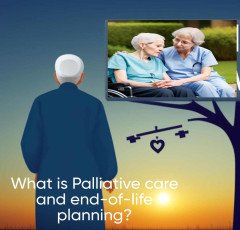
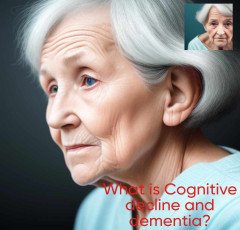

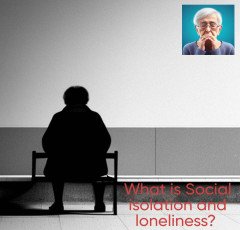
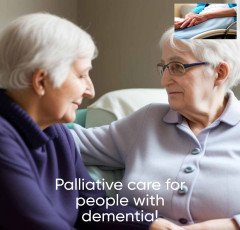
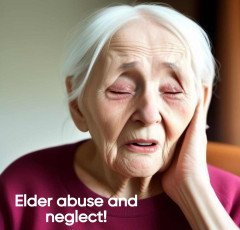
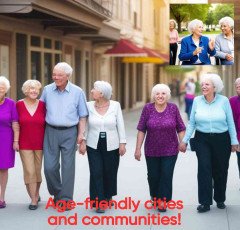






 HP Laptop
HP Laptop  Echo Dot - Smart speaker with Alexa
Echo Dot - Smart speaker with Alexa  Duke T Shirts
Duke T Shirts  Best Phone
Best Phone  One World Collection
One World Collection  Hanging Lights For Living Room
Hanging Lights For Living Room  Air Purifier for Home
Air Purifier for Home  Healthy Ingredients
Healthy Ingredients  Essentials for Gamers
Essentials for Gamers  Bathroom Mirrors
Bathroom Mirrors  ASUS Laptop
ASUS Laptop  1150+Trendy kids coloring pages Bundle
1150+Trendy kids coloring pages Bundle  Kitchen Tap
Kitchen Tap  NordVPN
NordVPN  Online Marketing
Online Marketing  Amazon Best Selling Products
Amazon Best Selling Products  Women Fashion
Women Fashion  ASPINAL LONDON
ASPINAL LONDON  TitTok Revolution
TitTok Revolution  Hot Bags For Pain Relief
Hot Bags For Pain Relief  BEST SELLER TOP10
BEST SELLER TOP10  Only For The United States
Only For The United States  All Wireless Products
All Wireless Products  Kitchen Daily Use
Kitchen Daily Use  Smart Doorbell
Smart Doorbell  Pet Care Products
Pet Care Products  Digital Voice Recorder
Digital Voice Recorder  Best Home Appliances
Best Home Appliances  Wireless Bluetooth Earphones
Wireless Bluetooth Earphones  ELECTRONIC ACCESSORIES
ELECTRONIC ACCESSORIES  The Secret Email System
The Secret Email System  Door Handle Collection
Door Handle Collection  Men Clothing
Men Clothing  Stylish Sneakers by Red Tape
Stylish Sneakers by Red Tape  Samsung Mobile
Samsung Mobile  Best Selling Books
Best Selling Books  Acer Laptop
Acer Laptop  iPhone cable
iPhone cable  The Click Engine
The Click Engine  Motion Sensor Light
Motion Sensor Light  Wall Lamp
Wall Lamp  SEO Checklist
SEO Checklist  Best Sellers On Amazon
Best Sellers On Amazon  SOFAS
SOFAS  Prime Video
Prime Video  Creative Brief For Video Shoot
Creative Brief For Video Shoot  Graphics & Design
Graphics & Design  NordLocker
NordLocker  NordPass
NordPass  Realme Smart Phone
Realme Smart Phone  Favorite Company (Cuelinks)
Favorite Company (Cuelinks)  Hello Theme
Hello Theme  Smart Watches
Smart Watches  Artificial Intelligence
Artificial Intelligence  Puma (Clothing & Accessories)
Puma (Clothing & Accessories)  Top Rated From Amazon
Top Rated From Amazon  4k Projector For Home
4k Projector For Home  Dual USB Car Charger
Dual USB Car Charger  Wireless Gaming Mouse
Wireless Gaming Mouse  Unreal Engine 5 For Beginners Learn The Basics Of Virtual Production
Unreal Engine 5 For Beginners Learn The Basics Of Virtual Production  Wristbands
Wristbands  Best Robotic Vacuum Cleaners
Best Robotic Vacuum Cleaners  RPM 3.0
RPM 3.0  Online Technology Classes
Online Technology Classes  Adidas Shoes
Adidas Shoes  Dell Laptop
Dell Laptop  Unlimited access to classes on illustration, photography, design, film, music
Unlimited access to classes on illustration, photography, design, film, music  Apple iPhone
Apple iPhone  Home Decor Items
Home Decor Items  Rakhi
Rakhi  LCD Writing Tablet
LCD Writing Tablet  Sennheiser
Sennheiser  Crocs
Crocs 


















